After cutting back on frivolities failed to protect Americans from rising prices, many are turning to discount chains for their food needs.
According to an InMarket report, average spending on grocery products at discount chains jumped 71% between October 2021 and June 2020, as spending on the same items at grocery stores dropped 5%, noted The Wall Street Journal (Aug. 1).
The Department of Commerce’s statement that consumer spending rose 1.1% in June, up from 0.3% in May indicates that all consumers are paying more for their typical items. However, inflation is hitting some harder than others.
Discount chains such as Dollar General have increased their sales forecasts as Americans in low, and now middle-income brackets are finding new ways to fill their pantries.
Dollar Store vs. Grocery Store
“Dollar stores are our fastest-growing segment,” said Brett Rose, Founder and CEO at United National Consumer Suppliers, an international wholesale distribution company providing products to Dollar Tree and its subsidiary Family Dollar. “They are strategically placed globally, not just in lower income or food desert areas. However, their smaller footprint and nimbleness, give them the ability to turn on a dime and meet the needs of their customers in their communities.
“You can find a deal on vast variety of items such as a frozen pizza, a gallon of milk, or a notebook.”
A spokesperson for Dollar Tree told The Wall Street Journal that the chain seeks to complement, not replace, grocery stores. While the stores often do not offer fresh produce, most of the 16,162 stores offer frozen fruits and vegetables. That’s one reason some critics argue that discount stores can exacerbate food deserts.
However, out of the 18,000 Dollar General locations, around 2,300 stock fresh produce with hopes to expand that number to 10,000 soon, according to a company spokesperson.
Digital Tools Bolstering Dollar Store Growth
Even when fresh items are available, Sean Turner, Co-Founder and CTO of Swiftly Systems, emphasized that inflation-crunched consumers are opting for frozen items and generic brands.
Turner is also seeing consumers hunting for the lowest price, putting more of the cost on credit cards, and using more digital coupons – up to 40% more at some chains.
“Shoppers are getting much more planful about their shopping trips and much more intentional about what they buy,” Turner said. “When the economy was really strong and people had more cash available, people spent less time trying to optimize on ‘how do I save as much as possible?’
“But now people are investing that time to get the most bang for their buck …,” Turner added.












